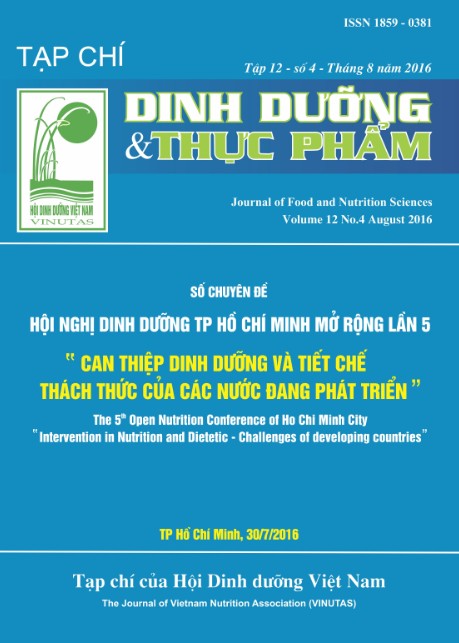NUTRITION FOR PREGNANT WOMEN – CHALLENGES IN CHRONIC DISEASES’ PREVENTION
Main Article Content
Abstract
Nutrition has an important role for pregnant women. Appropriate diet of the mother during pregnancy has a direct impact on the baby from a fetus until adulthood. In Vietnam, double burden is still affecting pregnant women. Malnutrition is still common in pregnant women. 19.6% of reproductive aged women suffer from chronic energy deficiency. Prevalence of anemia, iodine deficiency, and zinc deficiency is 36.5%, 72.8%, 34.6%. Malnutrition can cause severe consequences, such as birth defects, fetal malnourished babies, mortality, non-communicable chronic diseases in adulthood. The diet should provide sufficient recommended dietary allowance for energy, protein, carbohydrates, fats, vitamins, minerals and should ensure that maternal weight gain during pregnancy will be after the body mass index before pregnancy. Some micronutrients such as iron, folic acid are mandatory daily supplements because the demands increase during pregnancy. The fact that intrauterine growth retardation may predispose to nutrition-related chronic disease has serious implications for developing countries, particularly those undergoing rapid nutritional transition, as it may further increase the rates of obesity, cardiovascular disease and diabetes when diets and lifestyles are in themselves "atherogenic". The challenge is for programmes to simultaneously combat apparently opposite nutrition problems, malnutrition and "over-nutrition". Improving the nutrition of women is even more imperative when considering that it may contribute to preventing chronic diseases in the next generation, in addition to enhancing health and survival of mothers and children.
Keywords
Recommended dietary allowance, micronutrient, pregnant women, Vietnam
Article Details
References
2. Bộ Y tế (2012). Nhu cầu dinh dưỡng khuyến nghị cho người Việt nam. Nhà xuất bản Y học.
3. Bộ Y tế (2010). Tổng điều tra dinh dưỡng 2009-2010.Nhà xuất bản Y học.
4. Lancet (2012). Maternal and child undernutrition.
5. Nguyễn Nhân Thành, Trần Thị Minh Hạnh, Phan Nguyễn Thanh Bình, Phạm Ngọc Oanh, Đỗ Thị Ngọc Diệp, Lê Thị Kim Quí (2010). Tình trạng thiếu máu dinh dưỡng ở phụ nữ có thai, bà mẹ cho con bú và trẻ dưới 5 tuổi tại TP.HCM. Tạp chí Dinh dưỡng và Thực phẩm Tập 6 (số 3+4).
6. Nguyễn Thanh Danh,Trần Thị Minh Hạnh, Phan Nguyễn Thanh Bình, Nguyễn Nhân Thành, Đỗ Thị Ngọc Diệp, Lê Thị Kim Quí (2010). Tình trạng thiếu kẽm và các yếu tố liên quan ở phụ nữ có thai tại TP.HCM. Tạp chí Dinh dưỡng và Thực phẩm Tập 6 (số 3+4).
7. Tạ Thi Lan, Đỗ Thị Ngọc Diệp, Trần Bích Vân, Phạm Ngọc Oanh, Vũ Tiến Dũng (2014). Bổ sung i ốt vào hạt nêm góp phần giải quyết tình trạng thiếu hụt i ốt cho cộng đồng. Tạp chí Dinh dưỡng và Thực phẩm Tập 10 (số7).
8. Trần Thị Minh Hạnh, Phạm Ngọc Oanh, Phan Nguyễn Thanh Bình, Nguyễn Nhân Thành, Đỗ Thị Ngọc Diệp, Lê Thị Kim Quí (2010). Tình trạng thiếu i ốt ở phụ nữ có thai tại TP.HCM. Tạp chí Dinh dưỡng và Thực phẩm Tập 6 (số 3+4).
9. Trần Thị Minh Hạnh, Vũ Quỳnh Hoa, Phạm Ngọc Oanh, Đỗ Thị Ngọc Diệp, Lê Thị Kim Quí (2010). Tình trạng thiếu vi chất ớ phụ nữ mang thai tại TPHCM. Hội nghị khoa học toàn quốc Hội Dinh dưỡng Việt nam.
10.WHO (2012). Guideline daily iron and acid folic supplementation in pregnant women.
11.WDelisle H. (2002). Foetal programming of nutrition-related chronic diseases. Sante12(1):56-63.
12.US Institute of Medicine. Guidelines weight gain during pregnancy. 2009.


